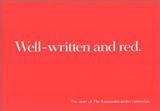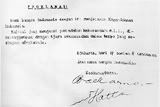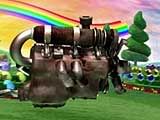I Never Read The Economist.
"I never read The Economist (Management Trainee, Aged 42)", "E=iq2", "The majority of people don't get it.", "Is your dome worth a visit?" "Ignore obstacle.", "Brain Poster", "Rest your case", "Can I phone an Economist's reader please Chris?", "A poster should contain no more that eight words, which is the maximum the average reader can take in a single glance. This, however, is a poster for Economist readers.", "Retire early with a good read." are some of so many works of The Economist magazine. It's a long established campaign by agency called AMV BBDO in London. It's everywhere, from magazine, billboard, doormat, and many innovative media with striking power: WELL WRITTEN and RED, a white out of red ads.
It's garnered bucks of award metal around the globe. Now, after reading this amazing magazine (hey, make our brain bigger!), you can also read the book that tells the history of nurturing the brand. WELL WRITTEN AND RED is the title of the book. Amazon.com reviewed this book as 5 stars book in its category.
Written by one of Britain's most respected advertising copywriters, Alfredo Marcantonio, it celebrates the 15th anniversary of the first appearance of these eye catching and mould breaking 'White out of Red' billboards.
As an ex-Director of AMV BBDO, the Agency responsible, he paints a remarkably insightful picture, not only of the conception and development of the award-winning creative work, but also of the Agency/ Client relationship that has nurtured it.
Marcantonio weaves together the recollections of those actually involved, putting events into context or stressing their importance, by citing lessons he has learnt in his own distinguished career.
This is clearly a 'must-have publication' for advertising, marketing and media people. However, poster headlines like 'In real life the tortoise loses' mean that it will appeal to anyone who appreciates wit and style. Indeed, if you have ever wondered how advertising works this book describes the process in engaging detail.
Readers from outside the industry won't be fazed by the vagaries of the creative process described in this book. Instead, they may be surprised to discover the disciplined strategic thinking and tight advertising briefs that inspire it, and the way subtle shifts in emphasis have helped the campaign remain relevant in changing times.
This 224 page hardback and features 140 or more of the advertisements that have helped The Economist increase its UK circulation by 65% and its UK ad revenue by 250%. It is a testimony to the power of posters, confirmation that it can pay to advertise and proof that 'funny' need not be the enemy of 'money'.
Born in England but of Italian parentage, Alfredo Marcantonio began his advertising career as a client. Initially at Colt and then at Volkswagen.
Inspired by the work of Doyle Dane Bernbach, VW's agency, he quit his job as Head of Advertising to become a copywriter.
In the mid 70's he joined Collett Dickenson Pearce, then regarded as one of the most creative agencies in the world, and in 1981 he helped CDP's Frank Lowe and Geoff Howard-Spink to found Lowe Howard-Spink.
He resigned as Creative Director and Deputy Chairman in 1987 to run Wight Collins Rutherford Scott, adding his long name to its already lengthy title. When the agency was taken over by Eurocom, Marc ran BBDO until its merger with Abbot Mead Vickers.
With the merger came the opportunity to return to his first love, writing ads.
He went on to become Vice Chairman of AMV BBDO in London and Creative Vice President of BBDO in Italy.
In 1999 he joined Interpublic as Executive Creative Director of all General Motors' advertising produced by Lowe and McCann in Europe. More recently, Marc was Creative Director of the Italian office of the Italian office of Leagas Delaney, the small but highly creative British-based advertising agency group.
As a writer and creative director, he has been involved in the development of some of Britain's most successful and most popular advertising campaigns including Hamlet, Heineken, BMW and Carling Black Label.
Marc is co-author of 'Remember Those Great VW Ads?' which is now in its third edition and he was invited to contribute to 'The Copy Book', a highly regarded compilation that showcases the work of the world's best copywriters.




